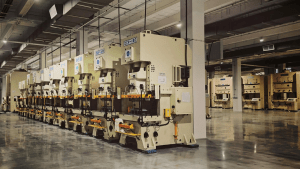This surge in automation is reshaping how products are picked, packed, and shipped, with Amazon reporting that 75% of all customer orders are now handled, in some way, by these sophisticated machines.
The Rise of Vulcan and Delivery Drones
At the heart of this transformation is Amazon’s latest innovation: the Vulcan robot — an advanced, heavy-lifting machine designed to optimize warehouse operations. Alongside Vulcan, Amazon has ramped up its delivery drone program, aiming to shorten last-mile delivery times and reduce dependency on traditional vehicle fleets.
These combined innovations are projected to save Amazon an estimated $16 billion annually by 2032, thanks to improvements in efficiency, reduced labor costs, and fewer logistical bottlenecks. According to analysts, such savings could potentially push Amazon’s retail profit margins from 5.4% in 2024 to an impressive 11% over the next seven years.
A Broader Industry Shift
Amazon’s leap into automation is not just about speed and savings. It’s part of a broader industry trend where major retailers are investing heavily in AI, robotics, and machine learning to stay competitive in a rapidly evolving marketplace. By integrating smart robots with advanced AI algorithms, Amazon can dynamically adjust warehouse workflows, anticipate demand spikes, and ensure that customer deliveries remain both fast and accurate.
Furthermore, the company’s use of autonomous mobile robots (AMRs) — such as the Hercules, Proteus, and Sparrow models — has reduced the physical strain on human workers, who can now focus on more specialized tasks like quality control and complex packaging.

Economic and Social Impact
The scale of Amazon’s robotics deployment has significant economic implications. While it raises ongoing debates about the future of human jobs in the retail and logistics sectors, Amazon emphasizes that its automation strategy is about augmenting human capabilities, not replacing them. The company has continued to hire thousands of workers, especially for roles that require creative problem-solving and customer service, demonstrating how automation and human labor can coexist.
Analysts suggest that Amazon’s innovations could serve as a blueprint for other industries, including healthcare, manufacturing, and transportation, where automation and AI are poised to drive similar transformations.
Looking Ahead
As Amazon continues to invest in cutting-edge robotics and artificial intelligence, the company is not only redefining the retail landscape but also setting a new standard for operational excellence. With billions in projected annual savings and a more efficient, tech-driven supply chain, Amazon is positioned to lead the next decade of global commerce innovation.
Source:
Amazon Investor Relations (official quarterly updates), Amazon Corporate Newsroom, Prime Air Program Announcements



 Share your Details for subscribe
Share your Details for subscribe